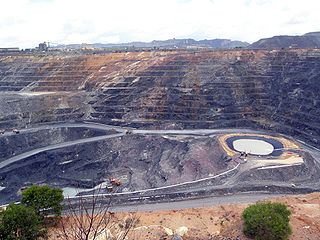Related Research Articles

The uranium market, like all commodity markets, has a history of volatility, moving with the standard forces of supply and demand as well as geopolitical pressures. It has also evolved particularities of its own in response to the unique nature and use of uranium.

Uranium mining is the process of extraction of uranium ore from the ground. Over 50 thousand tons of uranium were produced in 2019. Kazakhstan, Canada, and Australia were the top three uranium producers, respectively, and together account for 68% of world production. Other countries producing more than 1,000 tons per year included Namibia, Niger, Russia, Uzbekistan, the United States, and China. Nearly all of the world's mined uranium is used to power nuclear power plants. Historically uranium was also used in applications such as uranium glass or ferrouranium but those applications have declined due to the radioactivity of uranium and are nowadays mostly supplied with a plentiful cheap supply of depleted uranium which is also used in uranium ammunition. In addition to being cheaper, depleted uranium is also less radioactive due to a lower content of short-lived 234
U and 235
U than natural uranium.

National Atomic Company Kazatomprom Joint Stock Company (Kazatomprom) (Kazakh: Қазатомөнеркәсіп, romanized: Qazatomónerkásip) is the world’s largest producer and seller of natural uranium, providing over 40% of global primary uranium supply in 2019 from its operations in Kazakhstan. Kazatomprom's uranium is used for the generation of nuclear power around the world.
Energy in Kazakhstan describes energy and electricity production, consumption and import in Kazakhstan and the politics of Kazakhstan related to energy.

Uranium One is an international group of companies, part of the management circuit of the TENEX Group of Rosatom State Corporation. Since 2013, it is a wholly owned subsidiary of Moscow-based Uranium One Group, a part of the Russian state-owned nuclear corporation Rosatom.
The mineral industry of Kazakhstan is one of the most competitive and fastest growing sectors of the country. Kazakhstan ranks second to Russia among the countries of the CIS in its quantity of mineral production. It is endowed with large reserves of a wide range of metallic ores, industrial minerals, and fuels, and its metallurgical sector is a major producer of a large number of metals from domestic and imported raw materials. In 2005, its metal mining sector produced bauxite, chromite, copper, iron, lead, manganese, and zinc ores, and its metallurgical sector produced such metals as beryllium, bismuth, cadmium, copper, ferroalloys, lead, magnesium, rhenium, steel, titanium, and zinc. The country produced significant amounts of other nonferrous and industrial mineral products, such as alumina, arsenic, barite, gold, molybdenum, phosphate rock, and tungsten. The country was a large producer of mineral fuels, including coal, natural gas, oil, and uranium. The country's economy is heavily dependent on the production of minerals. Output from Kazakhstan's mineral and natural resources sector for 2004 accounted for 74.1% of the value of industrial production, of which 43.1% came from the oil and gas condensate extraction. In 2004, the mineral extraction sector accounted for 32% of the GDP, employed 191,000 employees, and accounted for 33.1% of capital investment and 64.5% of direct foreign investment, of which 63.5% was in the oil sector. Kazakhstan's mining industry is estimated at US$29.5 billion by 2017.

Radioactive ores were first extracted in South Australia at Radium Hill in 1906 and Mount Painter in 1911. 2,000 tons of ore were treated to recover radium for medical use. Several hundred kilograms of uranium were also produced for use in ceramic glazes.

For many years, North America was the largest exporter of uranium ore in the world and has been a major world producer since demand for uranium developed. In 2009 Kazakhstan took over top spot, relegating Canada to second. 20% of the world's primary uranium production came from mines in Canada in 2009. 14.5% of the world production came from one mine, McArthur River. Currently the only producing area in Canada is northern Saskatchewan, although other areas have had active mines in the past.
Inkai is a uranium mine located in Kazakhstan. Commercial production commenced in 2009, with the main processing plant being commissioned in 2010.

The uranium mining debate covers the political and environmental controversies of the mining of uranium for use in either nuclear power or nuclear weapons.
The world's largest producer of uranium is Kazakhstan, which in 2019 produced 43% of the world's mining output. Canada was the next largest producer with a 13% share, followed by Australia with 12%. Uranium has been mined in every continent except Antarctica.

Uranium mining in Kazakhstan is of considerable importance to the national economy. By 2011, Kazakhstan was considered to be the world's largest producer of uranium.
The Akdala mine is a large in-situ leaching mine located in the southern part of Kazakhstan in Almaty Province. Akdala represents one of the largest uranium reserves in Kazakhstan having estimated reserves of 43.5 million tonnes of ore grading 0.036% uranium.
The South Inkai mine is a large in-situ leaching mine located in the southern part of Kazakhstan in South Kazakhstan Province. South Inkai represents one of the largest uranium reserves in Kazakhstan having estimated reserves of 135.4 million tonnes of ore grading 0.026% uranium.
The Karatau mine is a large in-situ leaching mine located in the southern part of Kazakhstan in South Kazakhstan Province. Karatau represents one of the largest uranium reserves in Kazakhstan having estimated reserves of 70.4 million tonnes of ore grading 0.05% uranium.
The Akbastau mine is a large in-situ leaching mine located in the southern part of Kazakhstan in South Kazakhstan Province. Akbastau represents one of the largest uranium reserves in Kazakhstan having estimated reserves of 66 million tonnes of ore grading 0.077% uranium.
The Zarechnoye mine is a large in-situ leaching mine located in the southern part of Kazakhstan in South Kazakhstan Region. Zarechnoye represents one of the largest uranium reserves in Kazakhstan having estimated reserves of 90 million tonnes of ore grading 0.036% uranium.

The Moiynkum Desert, is a desert in the Turkistan and Zhambyl regions of southern Kazakhstan.

Koshkar-Ata is a lake in Mangystau Region, southwest Kazakhstan. It lies 5 km (3.1 mi) north of the regional capital of Aktau and 8 km (5.0 mi) from the shores of the Caspian Sea. It is 36 m (118 ft) below sea level. It is a serious environmental and health hazard.
References
- ↑ "Kharasan Mine". uranium1.com. 2013. Retrieved 2013-06-25.